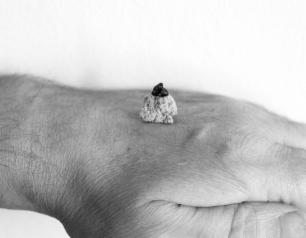Merlin Young - gentle and effective acupuncture for everyone
Moxa
Moxa uses the refined product of the selectively picked leaves of the mugwort plant which are smouldered over specific points on the skin in specific ways.
This plant grows all over the temperate zones of the northern hemisphere, and is generally classified as a weed, although it still has a reputation for its more esoteric properties in many traditional cultures. (The Anglo-Saxons, for instance, defined mugwort as one of their nine sacred herbs). It is only in the East Asia, however, that it has been used therapeutically by being burnt over the skin.

There are wide variations in the way this is done.
Generally more "direct" techniques involve smouldering cones of moxa (ranging in size from that of a sesame seed to larger ones more like broad beans) on the skin itself. When burnt over acu-points these either provide a warming effect (at which point the cones are lifted off) or (using tiny grain-sized cones) they produce a tiny "pinch" of heat. More indirect techniques popularly use a sort of cigar of moxa waved over areas of skin or around inserted needles. Other indirect methods involve burning loose clumps of moxa on the handles of needles to provide a wonderful penetrative and relaxing warmth, or burning cones on top of slices of other materials for compound effects - garlic or ginger are most often used.
Moxa was first referred to in the Chinese literature by some of the famous Chinese philosophers. It's highly likely, I think, that it was originally developed as a therapy by the nomads of Central Asia who probably used it as a tinder. More certainly, however, its early use in China actually provided the seminal theoretical inspiration for meridian-focused holistic acupuncture two thousand years ago. Since then, it's endured a mixed experience alongside acupuncture - often relegated almost to folk medicine status alongside the scholastic studies and developments in acupuncture over the centuries.
Its effects, however, should not be sniffed at. It is quite arguable that twentieth century Japanese research into responses to direct moxibustion provide better positive indicators of whole body responses than the results of research into acupuncture itself - particularly in respect of changes in blood chemistry, in immune response and relating to effects within the autonomic nervous system. It's also interesting that, early in the twentieth century, it was being successfully used to treat TB and as a tool to counter outbreaks of cholera.
For us today the power of the application of moxa is two-fold: firstly it can give a special "edge" to the treatment of chronic or difficult conditions; secondly its basic technique can be taught to the patient who can then use it at home to support the treatment. With both approaches I have sometimes seen it make a staggering difference to the overall treatment effect.
Jenny Craig (another UK acupuncturist) and myself thoroughly investigated the record of its use in the 1930s in Japan to treat TB before the advent of antibiotics. The real possibility revealed itself that it just might have a significant role to play today in the developing world where drugs and appropriate diagnosis are so shamefully scarce. To this end, a charity now exists (Moxafrica) to seriously systematically investigate this possibility.
Unfortunately, of course, in many clinics in our so-called "developed" world, the use of moxa is precluded because of its smoke. It's certainly not toxic, like cigarette smoke is for instance, but it creates smoke nevertheless, and I can attest to the fact that it will set smoke alarms off having once embarrassingly been responsible for the automatic call out of a fire engine.
For anyone who is particularly interested in either moxa or mugwort, I have a book published on the subject which I think is the most comprehensive in the English language - "The Moon over Matsushima - Insights into Moxa and Mugwort".


